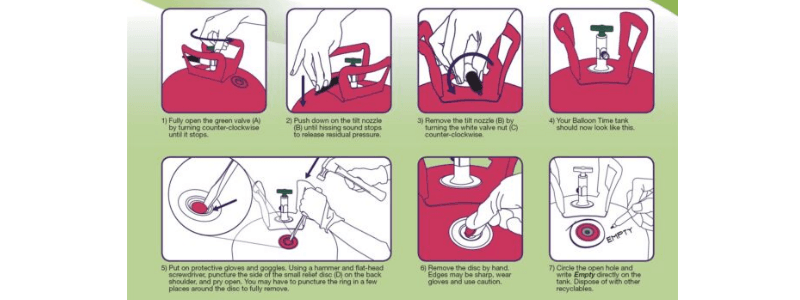Helium tanks are widely used for inflating balloons, powering blimps and even for welding and cutting operations. With an increasing demand for helium tanks, it's essential to understand the importance of properly disposing of them once they are empty.
The Consequences of Improper Disposal
When helium tanks are not disposed of correctly, they can have severe environmental consequences. Helium tanks are made of steel and aluminum, which can take hundreds of years to decompose in landfills. They can also release harmful chemicals into the environment if not properly handled. Additionally, if not disposed of correctly, helium tanks can also pose a danger to people and animals.

The Recycling Process
Fortunately, helium tanks can be recycled and repurposed. The recycling process starts by thoroughly cleaning the tanks to remove any leftover gas or residue. The tanks are then crushed and melted down to be used as raw materials for new products. Steel from the tanks can be used to make new tanks, while aluminum can be used in the production of new cans and bottles.
Initiatives to Reduce Waste
Many companies and organizations have initiatives to help reduce the amount of helium tank waste. Some companies offer exchange programs where customers can bring in their empty tanks and exchange them for full ones. Charities and non-profits also organize events to collect and properly dispose of used tanks.
Frequently Asked Questions
Q: Can I just throw my helium tank in the trash?
A: No, it is illegal to dispose of helium tanks in the trash in most areas. They must be properly recycled or disposed of through a designated program.
Q: How do I know if my helium tank is empty?
A: A simple way to check if your tank is empty is to shake it. If you don't hear any liquid or gas moving inside, it's likely empty.
Q: Can helium tanks be refilled?
A: No, once a helium tank is empty, it cannot be refilled. It must be properly recycled or disposed of.
Conclusion
Properly disposing of helium tanks is essential to protecting the environment and ensuring the safety of people and animals. With recycling and exchange programs available, there are plenty of options for properly disposing of these tanks. By taking the time to properly dispose of these tanks, we can reduce waste and ensure a cleaner, safer world for future generations.










